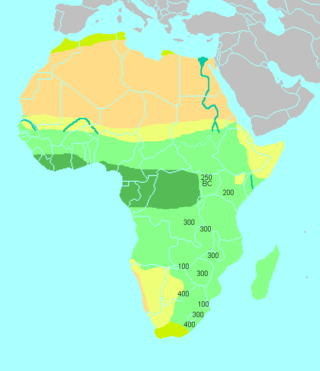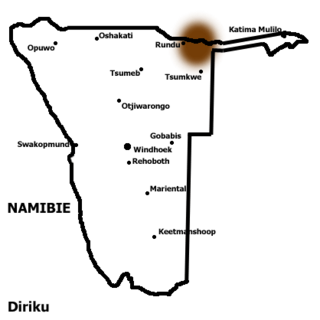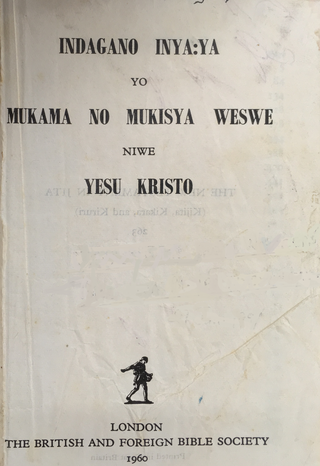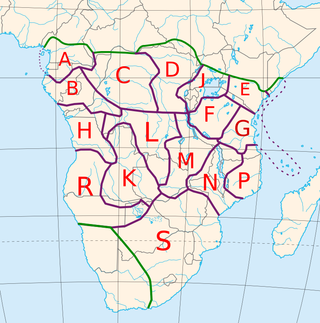Related Research Articles

The Bantu languages are a large family of languages spoken by the Bantu people of Central, Southern, and Southeast Africa. They form the largest branch of the Southern Bantoid languages.
The Tutsi, or Abatutsi, are an ethnic group of the African Great Lakes region. They are a Bantu-speaking ethnic group and the second largest of three main ethnic groups in Rwanda and Burundi.

The Bantu expansion is a hypothesis about the history of the major series of migrations of the original Proto-Bantu-speaking group, which spread from an original nucleus around Central Africa across much of sub-Saharan Africa. In the process, the Proto-Bantu-speaking settlers displaced or absorbed pre-existing hunter-gatherer and pastoralist groups that they encountered.

Herero is a Bantu language spoken by the Herero and Mbanderu peoples in Namibia and Botswana, as well as by small communities of people in southwestern Angola. There were 211,700 speakers in 2014.
Tooro, or Rutooro, is a Bantu language spoken mainly by the Toro people (Batooro) from the Toro Kingdom region of western Uganda. There are three main areas where Rutooro as a language is mainly used and they are Kabarole District, Kyenjojo District and Kyegegwa District. Rutooro is unique among Bantu languages as it lacks lexical tone. It is most closely related to Runyoro.
Myene is a cluster of closely related Bantu varieties spoken in Gabon by about 46,000 people. It is perhaps the most divergent of the Narrow Bantu languages, though Nurse & Philippson (2003) place it in with the Tsogo languages (B.30). The more distinctive varieties are Mpongwe (Pongoué), Galwa (Galloa), and Nkomi.
Tswa (Xitswa) is a South-Eastern Bantu language in Southern Mozambique. Its closest relatives are Ronga and Tsonga, the three forming the Tswa–Ronga family of languages.
Kwangali, or RuKwangali, is a Bantu language spoken by 85,000 people along the Kavango River in Namibia, where it is a national language, and in Angola. It is one of several Bantu languages of the Kavango which have click consonants; these are the dental clicks c and gc, along with prenasalization and aspiration.

Gciriku or Dciriku, is a Bantu language spoken by 305,000 people along the Okavango River in Namibia, Botswana and Angola. 24,000 people speak Gciriku in Angola, according to Ethnologue. It was first known in the west via the Vagciriku, who had migrated from the main Vamanyo area and spoke Rugciriku, a dialect of Rumanyo. The name Gciriku remains common in the literature, but within Namibia the name Rumanyo has been revived. The Mbogedu dialect is extinct; Maho (2009) lists it as a distinct language, and notes that the names 'Manyo' and 'Rumanyo' are inappropriate for it.
Mbugwe or Mbuwe (Kimbugwe) is a Bantu language of spoken by the Mbugwe people of Lake Manyara in the Manyara Region of Central Tanzania. Mbugwe is estimated to be spoken by some 34,000 people.
The Zigula or Zigua language, Chizigua, is a Bantu language of Tanzania and Somalia, where the Mushunguli dialect is spoken.
Luyana (Luyaana), also known as Luyi, is a Bantu language spoken in Zambia and perhaps in small numbers in neighboring countries. It appears to be an divergent lineage of Bantu. It is spoken by the Luyana people, a subgroup of the Lozi people.
The Nen language, Tunen (Banen), is a Bantu language of Cameroon. Maho (2009) considers Aling'a to be a distinct language. Unlike all other Bantu languages, Nen has an SOV word order rather than the standard Bantu SVO word order.
Taita is a Bantu language spoken in the Taita Hills of Kenya. It is closely related to the Chaga languages of Kenya and Tanzania. The Saghala variety is distinct enough to be considered a language separate from the Daw'ida and Kasigau dialects.

Jita is a Bantu language of Tanzania, spoken on the southeastern shore of Lake Victoria/Nyanza and on the island of Ukerewe.

The Bantu peoples, or Bantu, are an ethnolinguistic grouping of approximately 400 distinct ethnic groups who speak Bantu languages. They are native to 24 countries spread over a vast area from Central Africa to Southeast Africa and into Southern Africa. There are several hundred Bantu languages. Depending on the definition of "language" or "dialect", it is estimated that there are between 440 and 680 distinct languages. The total number of speakers is in the hundreds of millions, ranging at roughly 350 million in the mid-2010s. About 60 million speakers (2015), divided into some 200 ethnic or tribal groups, are found in the Democratic Republic of the Congo alone.
Simaa is a Bantu language of Zambia. It was assigned by Guthrie to Bantu group K.30, which Pfouts (2003) established as part of the Kavango–Southwest branch of Bantu. Though not specifically addressed, Simaa may be in that family as well.
Mashi (Kamaxi), or Kwandu, is a Bantu language of Zambia and Angola. It was assigned by Guthrie to Bantu group K.30, which Pfouts (2003) established as part of the Kavango–Southwest branch of Bantu. Though not specifically addressed, Mashi may be in that family as well.
Suku is a Bantu language of the Democratic Republic of the Congo.
Vidunda (Chividunda) is a Bantu language spoken along the north bank of the Ruaha River in Tanzania. It belongs to the Ruvu branch of Northeast Coast Bantu.
References
- ↑ Jouni Filip Maho, 2009. New Updated Guthrie List Online
- ↑ Nurse & Phillipson 2003
- ↑ Bantu Classification Archived 2012-06-24 at the Wayback Machine , Ehret, 2009.